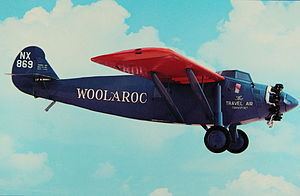First flight March 1926 Manufacturer Travel Air | Number built 13 | |
 | ||
Unit cost $23,000 for Dole Race models in 1927 Designers | ||
Restoration progress of a travel air 5000
The Travel Air 5000 was an early high-wing monoplane airliner and racing monoplane designed by Clyde Cessna and is chiefly remembered for being the winner of the disastrous Dole Air Race from California to Hawaii.
Contents
- Restoration progress of a travel air 5000
- 2 september 2014 travel air 5000 restoration update
- Design and development
- Operational history
- Survivor
- Operators
- Specifications Travel Air 5000
- References
2 september 2014 travel air 5000 restoration update
Design and development
Cessna broke away from traditional biplane development with a monoplane in 1926. The first prototype was a 5-passenger aircraft with an 110 hp (82 kW) Anzani engine. The aircraft was modified by Cessna, Lloyd Stearman and Walter Beech that fall. A second aircraft was built that December, and featured a Wright J-4 Whirlwind as the Travel Air 5000. National Air Transport awarded Travel Air a contract to produce the aircraft with the larger Wright J-5C engine and seating for four passengers. Eight aircraft were built for air mail contract and passenger service.
The Travel Air 5000 was a high-wing monoplane with conventional landing gear. The fuselage was constructed of welded steel tubing. The cockpit was fully enclosed in a canopy above the forward fuselage, but at least one model had the canopy omitted. The Dole racers were modified with 425 gallon fuselage fuel tanks and earth inductor compasses.
Operational history
The prototype Travel Air 5000, s/n 160 "The Spirit of Oakland" was originally sold to Pacific Air Transport in April 1927 and then resold to Ernest Smith for a 14 July flight from Oakland, California to Molokai, Hawaii where it crashed on landing becoming the second aircraft to complete a trans-pacific flight, and the first civilian aircraft to do so.
Orders placed in June 1927 for two custom-built Travel Air model 5000 aircraft to compete in the Oakland, California to Honolulu, Hawaii Dole Air Race. Two teams placed $5000 deposits, and were later sponsored by Frank Phillips of Phillips Petroleum to promote their "Nu-Aviation" fuel. The "Oklahoma" was forced to return to land, while the "Woolaroc" completed the flight and won.
Woolaroc was later modified late in 1928 for an unsuccessful transcontinental speed record attempt.
National Air Transport, and Royal Airways used the model 5000 in revenue service. Production of the first four airliners was in the West Douglas plant. On 30 June 1927 production of two Modified model 5000's started in the newly constructed East Central factory.
Survivor
The Travel Air 5000 "Woolaroc" which won the Dole Race is on display at the Woolaroc Museum in Bartlesville, Oklahoma.
Operators
Specifications (Travel Air 5000)
Data from Travel Air Restorers Association
General characteristics
Performance
